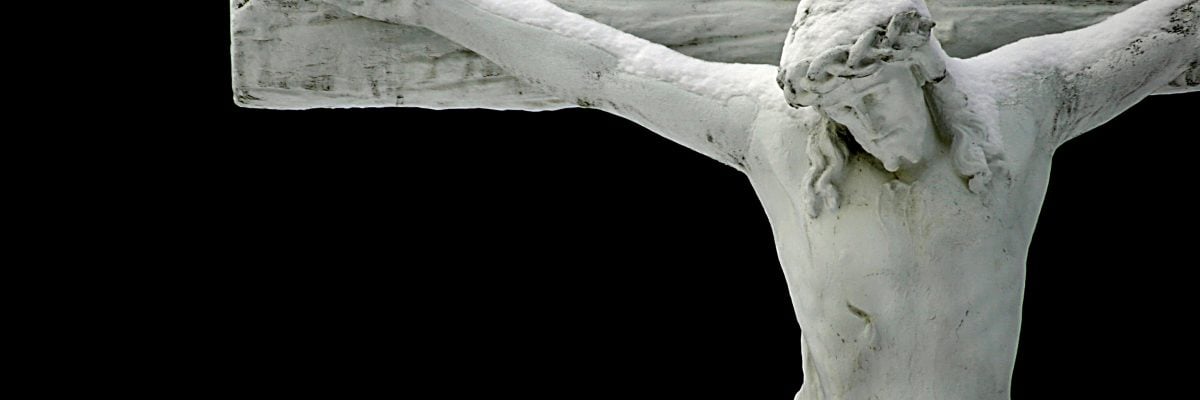
Homily for the Fifth Sunday of Lent, Year B
“Now is the time of judgment on this world;
now the ruler of this world will be driven out.
And when I am lifted up from the earth,
I will draw everyone to myself.”
He said this indicating the kind of death he would die.— John 12:31-33
Think of it: a graphic image of a man tortured to death: bled dry, bruised, contorted, abused, hideously mistreated. Imagine such an image on the walls of homes, in schoolrooms, at crossroads, in courtrooms, worn about the neck, and venerated in places of worship. Such is the figure of the crucified Savior throughout traditional Europe and Latin America—whether Catholic, Orthodox, or even Lutheran. Countless millions of men, women, and children will describe this image as beautiful, as moving, as attractive.
“’And when I am lifted up from the earth, I will draw everyone to myself.’ He said this indicating the kind of death he would die.” Perhaps it has never occurred to you, but consider that the attractiveness of the image of Jesus crucified constitutes a kind of continuous miracle, one of the many ways in which Our Lord’s prophecy is being fulfilled before our eyes each day. It is not simply to be taken for granted that an image of a man so tortured should be a sign of beauty and consolation. Mormons and Muslims and Jehovah’s Witnesses find this image offensive, and yet we who profess the Faith revealed by the Crucified One, find this image attractive, alluring, altogether consoling.
How is this? Can anyone explain it? It is relatively easy to appreciate the attractiveness of the Madonna and Child, or of Jesus with the children, or knocking at the door of our hearts, or risen and glorious, inviting us to come to him; but who can be drawn to a man stretched out in agony covered with blood and sweat, gasping for air, barely able to speak? And yet we are. How so?
In his Nichomachean Ethics, Aristotle said, “The good is what all things seek.” When something or someone is drawing another something or someone, it is because that thing or person is good. Goodness is attractiveness. The crucified Lord is the supreme revelation of the goodness of God.
But again, how so? It is because, on an even deeper level, that which is good is precisely so because it pours itself out on those who approach it. As the Platonists taught, before and along with Aristotle, “It is the nature of the good to pour itself out.” Goodness is attractiveness because goodness is a gift, a freely bestowed boon, just pouring itself out and not asking for anything in return, just hoping that we will receive the gift.
So the crucifix is the image of the Goodness, or the gift of God pouring himself out on all men and all things whatsoever. It draws us on because the cross is the supreme revelation of all the good that God has in store for us. No one who knows who is suffering on the cross and why he suffers can fail to be moved to rush forward and receive the gift he offers us.
And this gift is so perfect because he gives it to us in the very fact of his undergoing, his “passion,” of all the evil we have poured out on him: all our sins, grave and slight, all our weaknesses, all our betrayals and ingratitude, all of our self-deception and harshness toward others, all the ugliness of our sinful lives, which should render us supremely unattractive to him who is all lovely, all beautiful, all good! The crucifix tells us not of our goodness, but of our tragic defects, even as it tells us of the goodness of our God.
Here is the deepest level of this sign of attractive, diffusive love: The cross is the sign of God’s attraction to us. He longs for our love, he awaits the day of our repentance, he uses every proof of his love; even submitting himself to our indifference and ungratefulness, as long as there is a hope of our loving him. His arms are outstretched awaiting our embrace!
Jesus is the original and perfect human being in his Father’s eternal plan. And the driving force of human life is to love and be loved. There is no way around this. The suffering Son of God is a hero, yes, but one who earnestly longs that we rescue him from the bonds of death, of loneliness, neglect, rejection, abuse, and deep sorrow by our response to his great and surpassing gift.
“My soul is sorrowful even unto death, wait here and watch with me.” The apostles were not up to the task on the night before he was crucified, but they were later when he filled them with the promised Holy Spirit of divine love and they became the preachers of Christ crucified, to the ends of the earth.
They preached the Good News that God loves us so much that he underwent death and bore the whole weight of the sins of the world so that, soul by soul, we might be drawn to him who is so drawn to us, to his goodness in us. St Catherine of Siena describes the suffering Savior as “mad with love” for human beings: she calls him philocaptus— “ravished by love.”
As we prepare to celebrate the great mysteries of our salvation in Passiontide and Paschaltide, let us fix our hearts and loving gazes on the crucifix and let the goodness of the Savior pour itself out on us in the deep conviction that he loves us beyond all our images and imagination. For it is really true that even the crucifix is only a weak representation of his love for us. As the apostle tells us, “Eye has not seen, nor ear heard, nor has it entered into the heart of anyone what God has in store for those who love him.”
And what does he have in store for you and me? We can start to find out by getting to confession before Easter. There the power of the Crucified is poured out, and his love for us is confirmed. Give him this gift which he longed for as he gave himself already for the sins you will bring to him now. Peace!



